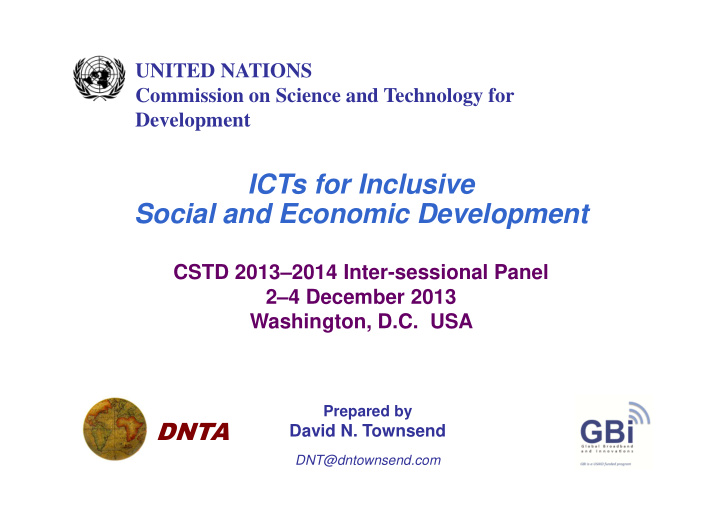



UNITED NATIONS Commission on Science and Technology for Development ICTs for Inclusive Social and Economic Development CSTD 2013–2014 Inter-sessional Panel 2–4 December 2013 Washington, D.C. USA Prepared by DNTA David N. Townsend DNT@dntownsend.com
ICTs for Inclusive Social and Economic Development Overview: Effective Policies for Promoting ICT Development � Kenya National Broadband Strategy � Colombia Vive Digital Program � Indonesia Broadband Plan � I, ME, MINE � 2
ICTs for Inclusive Social and Economic Development Effective Policies for Promoting ICT Development • Best Practices = Best Processes � National Broadband Strategies/Plans, Digital Agendas, etc.: Getting from Objectives to Outcomes � Structured, formal processes (Steering Committee) � High level authority and support � Open, inclusive, consultative � Establish objectives, targets, timetables � Market status and gap analysis � Costs and financing � Action Plans 3
ICTs for Inclusive Social and Economic Development Effective Policies for Promoting ICT Development • Ecosystem Approach � Ensure comprehensive and coordinated incorporation of all inter- related elements � Supply and demand � Infrastructure, access, services, devices � Policy and regulation � Applications, content � Capacity building, digital literacy � Funding sources and mechanisms 4
ICTs for Inclusive Social and Economic Development Effective Policies for Promoting ICT Development • Stakeholder Roles � Provide inputs to the planning process � Make commitments to participate in implementation � ICT suppliers (networks, services, equipment, software) � Government (national, local) � Public institutions (education, health, security, postal, community, libraries, etc.) � End users (consumers, businesses, govt as user) � Financial sector (banks, investors) � NGOs, donors, international partners, etc. 5
ICTs for Inclusive Social and Economic Development Kenya National Broadband Strategy � Cooperative policy development framework 6
ICTs for Inclusive Social and Economic Development Kenya National Broadband Strategy � Steering Committee leadership, oversight 7
ICTs for Inclusive Social and Economic Development Kenya National Broadband Strategy � Formalized, structured process 8
ICTs for Inclusive Social and Economic Development Kenya National Broadband Strategy � Ecosystem approach 9
ICTs for Inclusive Social and Economic Development Kenya National Broadband Strategy 10
ICTs for Inclusive Social and Economic Development Colombia Vive Digital Program � Ecosystem approach 11
ICTs for Inclusive Social and Economic Development Colombia Vive Digital Program 12
ICTs for Inclusive Social and Economic Development Colombia Vive Digital Program 13
ICTs for Inclusive Social and Economic Development Colombia Vive Digital Program � “Puntos Vive Digital” (PVDs): public access ICT centers 14
ICTs for Inclusive Social and Economic Development Indonesia Broadband Plan 15
ICTs for Inclusive Social and Economic Development Indonesia Broadband Plan 16
ICTs for Inclusive Social and Economic Development Indonesia Broadband Plan 17
ICTs for Inclusive Social and Economic Development I ME MINE = Innovative Mobile-Enabled Micro-Investment in the Networked Economy 18
ICTs for Inclusive Social and Economic Development I, ME, MINE = Innovative, Mobile-Enabled, Micro-Investment in the Networked Economy � Digital networks not only connect people socially, but can become a vital financial inclusion mechanism � As much as 75% in developing world don’t have bank accounts � Safaricom’s M-Pesa (Kenya, Tanzania, etc.) � Micro payments, transfers, on-line purchases, credit � ICT-driven development allows for (depends upon) E-entrepreneurs � On-line micro-businesses: mobile apps, e-commerce sites � Self-employed tech experts, info-tainment providers, etc. � Need paying customers, also investors 19
ICTs for Inclusive Social and Economic Development I, ME, MINE � E-finance, and e-investment, are not well established in most developing countries � ICT sectors have been built without local capital, finance � Banks are inexperienced, focus on safe, big investments � Start-ups need capital, credit, customers, time � Innovative solutions: � Mobile money payments, direct e-purchases � Crowd-sourced micro-investment (e.g., Kickstarter) � Venture capital funding of e-enterprise (e.g., Savannah Fund) � USAF co-financing of ICT incubators � Micro lending (e.g., Grameen) 20
ICTs for Inclusive Social and Economic Development I, ME, MINE Remittances � International remittances are a crucial input to development � Over $350 billion in payments into developing countries from 200 million ex-pat workers � Philippines: 10.5 million OFWs contribute > 10% of GDP � Mobile and Internet technology dramatically reduce cost and increase convenience, efficiency of remittances � Phone-to-phone transfers � Social network contacts, immediacy � Overseas remittances can also support micro-enterprises 21
ICTs for Inclusive Social and Economic Development I, ME, MINE Development Assistance, Aid � Mobile-enabled micro payments also significantly alter the options for development assistance, donations � Direct transfer payments via mobile money � Contributions to and by charities (global and local) � Reduced transaction costs, also increased performance data � Disaster relief and refugee aid � Haiti � Syria � Philippines 22
ICTs for Inclusive Social and Economic Development I, ME, MINE Text “RELIEF” to UNICEF: 864233 = $10.00 donation to Philippines typhoon victims Thank you DNT@dntownsend.com 23
Recommend
More recommend